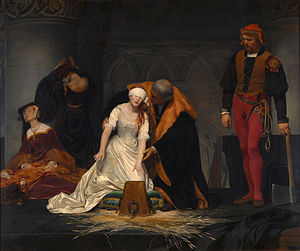The execution of Lady Jane Grey
Under the rule of Edward VI (r 1547-53) England became a Protestant country with the Church of England the only legal religion. By 1553 it was clear that Edward did not have long to live and that the heir, according to the will of their father Henry VIII, would be the Catholic loyalist, Edward’s half-sister Mary. The Duke of Northumberland, John Dudley, was the power behind the throne and sought to divert the succession away from Mary by marrying his son Guilford to Lady Jane Grey, a reliably Protestant royal cousin. Edward agreed to this in his will and directed the English political class to submit to Jane on his death.
When Edward died on July 6, 1553, Northumberland kept the death a secret while he tried to gain support for the 16-year-old Jane and arrest Mary. Though Jane was proclaimed Queen, her supporters in the main deserted her for the claims of Mary who was deemed to be the legitimate heir and not the puppet of the unpopular Dudley. After a reign of only 9 days, Jane stepped down and was arrested and imprisoned in the Tower of London. She was found guilty of treason but was not executed.
Early in 1554 a Protestant rebellion led by her father, the Duke of Suffolk, failed and in the aftermath he, Jane, and her husband were beheaded. England would be ruled by a Catholic who over the next four years would burn almost 300 Protestants at the stake and win the nickname Bloody Mary.

Gad, I love the Paul Delaroche picture; it’s one of the wonders of 19th Century Academic Art in all its glory. Look at everything that Delaroche does here. There are only five life-size figures, and they are superbly and dramatically placed within the frame. Lady Jane Grey is behaving with magnificent poise, which makes the emotional scene more poignant. She is on the scaffold and dressed only her undergarments. Her clothes are piled beside her lady-in-waiting, who has collapsed in grief against the left wall. Her other handmaiden faces the wall, the horror to come too much to bear.
Grey, blindfolded, reaches out for the chopping block where, moments later, her head will be cleaved from her body. Sir John Brydges, the lieutenant of the Tower, gently guides her to her death; his heart-breaking solicitude increases the emotional pitch of the picture. Even the executioner directs his gaze away, awed by the enormity of the sin he is about to commit. Look at how he shifts his weight to one leg, his right hand almost releasing the axe. Delaroche manages to depict different emotional reactions from the players of this tragedy, inspiring a multitude of emotional responses from us, the viewer.
Wisely, Delaroche keeps the representation of their surroundings to minimal gray-tones and subtle stone carvings. The bare stage, if you will, maintains focus on the figures and the deeply human connection is never lost. The one non-human touch of any significance is the straw surrounding the block; this, if nothing else, underscores the horror to come when we realize that it is there to soak up the young girl’s blood.
If we wonder how or why Delaroche was able to connect so viscerally with this particular historical incident, it would do well to remember that only a scant 40 years earlier, Delaroche’s countrymen cut off the heads of their own aristocracy.
By any yardstick, this is a magnificent and moving painting.
Thank you, Bob, for that splendid analysis. I’m writing a novel in which the poor girl features.
That is great news! Can’t wait to read it.